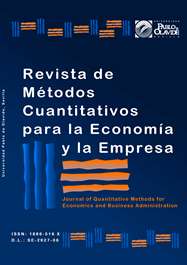Análisis exploratorio de estructuras temporales desde la óptica de tablas múltiples. Una aplicación
DOI:
https://doi.org/10.46661/revmetodoscuanteconempresa.2339Palabras clave:
series temporales, análisis factorial, tablas múltiples, time series, factorial analysis, multiple tablesResumen
En este trabajo se presenta un enfoque alternativo a los gráficos habituales de series temporales para su análisis comparativo exploratorio. Al disponer de varias series temporales medidas en diversos contextos, sugerimos su estructura en tablas múltiples para estudiar de forma adecuada sus similitudes y diferencias. El Análisis Factorial Múltiple (AFM) es la técnica seleccionada como la más idónea para alcanzar los objetivos planteados, a través de sus medidas numéricas y gráficas. Este enfoque del AFM supone una novedad, ya que en otros estudios el tiempo ha sido utilizado como criterio de estructuración de los grupos y no como unidad estadística como se plantea en este artículo. Una aplicación empírica a partir de datos mensuales, de los últimos 10 años, relativos a tres indicadores estrechamente relacionados con el turismo, desde el punto de vista de la demanda, y medidos en siete territorios nacionales, permite evidenciar la versatilidad y potencialidad de la propuesta.
Descargas
Citas
Abascal, E.; García-Lautre, I. y Landaluce M.I. (2004). “Análisis de la evolución a través de encuestas. Trayectoria electoral de las comunidades autónomas españolas en el periodo 1977-2004”. Metodología de Encuestas, Vol. 6, Nº 2, pp. 147-162
Abascal, E.; García-Lautre, I. y Landaluce, M.I. (2006). “Multiple factor analysis of mixed tables of metric and categorical data”. En M. Greenacre y J. Blasius (eds.): Multiple Correspondence Analysis and related Methods. Chapman & Hall/CRC, pp 351-367
Dazy, F. y Le Barzic, J.F. (1996). “L´Analyse des Données Evolutives”. Technip. Paris
Escofier, B. y Pagès J. (1986). “Le traitement des variables qualitatives et tableaux mixtes par analyse factorielle multiple”. Data Analysis and Informatics, IV(2), pp. 179-191
Escofier, B. y Pagès, J. (1992). “Análisis factoriales simples y múltiples. Objetivos, métodos e interpretación”. Servicio editorial de la Universidad de País Vasco.
Escofier, B. y Pagès, J. (1994). “Multiple factor analysis (AFMULT package)”. Computational Statistics & Data Analysis, 18(1), pp. 121-140.
Exceltur (2015). Alianza para la excelencia turística: Informe Perspectivas Turísticas, Nº 54.
Fernández, K.; Landaluce, M.I. y Modroño, J.I. (2013). “Nuevo procedimiento metodológico para el análisis exploratorio de una tabla estructurada en diversos conjuntos de individuos”. Estadística Española, Vol. 55, Nº 182, pp. 305-322.
García-Lautre, I. y Abascal, E. (2003). “Una metodología para el estudio de la evolución de variables latentes. Análisis de las infraestructuras de carreteras de las comunidades autónomas (1975-2000)”. Estadística Española, Vol. 45, Nº 153, pp. 193-210.
Goitisolo, B. (2001). “El análisis simultáneo. Propuesta y aplicación de un nuevo método de análisis factorial de tablas de contingencia”. Tesis doctoral. Universidad del País Vasco.
Landaluce, M.I. (1995). “Estudio de la estructura de gasto medio de las Comunidades Autónomas españolas. Una aplicación del Análisis Factorial Multiple”. Tesis doctoral. Universidad del País Vasco.
Robert, P. y Escoufier, Y. (1976). “A Unifying Tool for Linear Multivariate Statistical Methods: The RV-Coefficient”. Applied Statistics, 25(3), pp. 257-265.
SPAD v5.5 (2000). “Systéme Portable d’Analyse des Donées Numeriques”, CISIA, Montreuil, France.
Descargas
Publicado
Cómo citar
Número
Sección
Licencia
Derechos de autor 2016 Revista de Métodos Cuantitativos para la Economía y la Empresa

Esta obra está bajo una licencia internacional Creative Commons Atribución-CompartirIgual 4.0.
El envío de un manuscrito a la Revista supone que el trabajo no ha sido publicado anteriormente (excepto en la forma de un abstract o como parte de una tesis), que no está bajo consideración para su publicación en ninguna otra revista o editorial y que, en caso de aceptación, los autores están conforme con la transferencia automática del copyright a la Revista para su publicación y difusión. Los autores retendrán los derechos de autor para usar y compartir su artículo con un uso personal, institucional o con fines docentes; igualmente retiene los derechos de patente, de marca registrada (en caso de que sean aplicables) o derechos morales de autor (incluyendo los datos de investigación).
Los artículos publicados en la Revista están sujetos a la licencia Creative Commons CC-BY-SA de tipo Reconocimiento-CompartirIgual. Se permite el uso comercial de la obra, reconociendo su autoría, y de las posibles obras derivadas, la distribución de las cuales se debe hacer con una licencia igual a la que regula la obra original.
Hasta el volumen 21 se ha estado empleando la versión de licencia CC-BY-SA 3.0 ES y se ha comenzado a usar la versión CC-BY-SA 4.0 desde el volumen 22.










